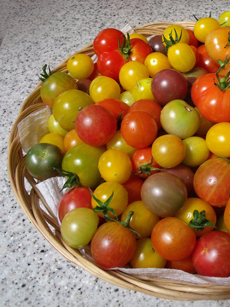February 26, 2014 at 8:43 am
· Filed under Entertaining, Food Fun, Tip Of The Day, Vegetables-Salads-Herbs
|

Baby carrots move beyond the familiar
orange to purple, red and yellow. Photo
courtesy Sprinkle Side Up. See her recipe for
glazed rainbow carrots.
|
|
In picking up supplies for our “diet Oscars menu,” we came across rainbow baby carrots—our first sighting—and rainbow cherry tomatoes, which have been available in our market for a few years.
Although we’re months from peak produce season, it got us thinking of how delightful it is to come across a familiar food with a fun twist. Most of the veggies below are natural mutations (as was red grapefruit and many other foods); some are cross-bred; none are GMO.
It’s not just about fun; there are nutritional benefits as well. Colored foods tend to be more antioxidant rich than pale and white foods. For example, orange cauliflower contains high levels of beta-carotene; purple cauliflower contains anthocyanin, an antioxidant that gives purple color to a variety of foods, including red cabbage and red onions. Green cauliflower just happens to have more protein than the other colors.
So today’s tip is: Keep an eye out and treat yourself to whatever is new and different. Grocers know that customers want new options, so even if there’s no farmers market near you, keep looking.
Then tell us what you found, and how you served it.
|
|
Bell peppers: Beyond the familiar green and red are black (purplish), orange, yellow and white bell peppers (photo). They all start out green, and ripen into the rainbow colors.
Colored cauliflower: Green, orange and purple cauliflowers are natural mutants of white cauliflower (which itself was bred to be whiter). Green cauliflower, also called broccoflower, has a lighter green cousin.
Romanesco: Also called Romanesque cauliflower, Romanesco broccoli and Romanesque cabbage, there’s a reason for the different names. Professional plant taxonomists can’t decide precisely where this exotic beauty belongs. A natural vegetable first discovered in Italy, it is one of the most beautiful vegetables imaginable (here’s a photo).
Eggplant: Beyond the familiar dark purple, also grows green (Thai eggplant), lavender, orange (Ethiopian, scarlet or Turkish eggplant), pink, and striped purple and white (graffiti eggplant) and white eggplant. The lighter colored eggplants tend to be less bitterness than the dark purple.
|
|
Purple green beans: These are a mutation where the skin of a regular green been grows violet. Alas, they are only purple when raw; cooking engenders the familiar green skin. But they sure are impressive crudités! (Photo and more information.) And don’t forget the yellow wax beans. A mix of green and yellow is interesting, and much more available.
Rainbow baby carrots: Shown in the photo above; the original carrot was white, like a turnip. The other colors—orange, purple, red, yellow—were mutants. Here’s the story.
Red leaf lettuce: There are quite a few varieties of red lettuce. Two of our favorites for “prettiest” are red fire lettuce (scroll past the green lettuce) and the beautifully spotted freckles lettuce.
Sweet red corn: Look for it during the summer corn season. (Photo.)
Swiss chard: Long familiar in green with red accents, check farmers markets to find it in vivid orange, pink, purple, yellow and white. (Photo.)
Tomatoes: Anyone who has visited a farmers market has seen the lush colors beyond red: brown, green, orange, purple, striped, yellow, white.
|
|

Cherry tomatoes photo courtesy Dianne Fritz.
|
Isn’t nature grand?
|
Please follow and like us:
Permalink
Comments are closed.




